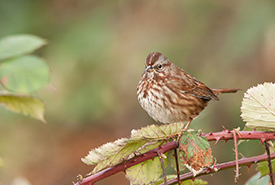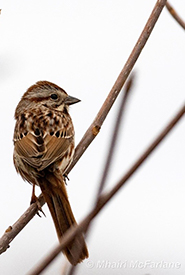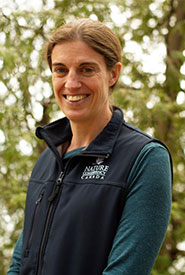Mhairi's bird of the day: Song sparrow

Song sparrow (Photo by Stuart Clarke)
Spotted on March 20, 2020
Song sparrow
Melospiza melodia
Melo: “song,” in ancient Greek
Melodia: “tune,” “voice”
For the last 10 years, I have been recording my bird observations on my daily bike commute to work, before we started working from home in light of the COVID-19 outbreak. My colleagues, who have been enjoying my daily updates of my sightings, invited me to share my observations in this four-part blog series. Read part one here.

One of my little song sparrow friends who was singing his heart out (Photo by Mhairi-McFarlane/NCC).
The thunderstorms held off for just long enough for me to pop out for a very muddy jaunt to another local park. [Ed: As this occurred in the early days of COVID-19, visiting local natural areas was still permitted.] As soon as I got out of the car, one of the most dominant sounds was that of the song sparrow — appropriate, given it is International Sparrow Day! These deceptively plain brown birds, or “little brown jobs/LBJ”, in birding parlance, have arrived back en masse in southern Ontario over the last few weeks. The males have taken up residence in shrubby areas in our gardens, parks and natural areas all around us. What they may lack in gauzy colours, they more than make up for in their songs. Although this one species occurs right across North America, they vary geographically in terms of their song. Local birds sound similar to their neighbours, but different from birds a few kilometres away.
Their song is really important: males sing to establish and defend territories, and to attract females. Males with a more complex song repertoire tend to attract more females and produce more offspring. Scientists have studied song sparrows for many years, in particular at the Queen’s University Biological Station.
Next time you walk outside, open your ears and see if you can hear a shrub singing to you. Look carefully, and see if you can spot the real culprit: a song sparrow.
Here’s my ebird checklist: https://ebird.org/checklist/S66001906


